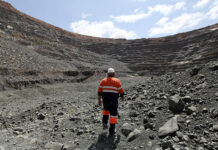
PETRA Diamonds CEO, Richard Duffy, said the diamond market had stabilised as 2019 drew to a close, and that there were early advances in the firm’s Project 2022 strategy, but the firm’s net debt was stubbornly high in the six months ended December.
Net debt as of December 31 was $596.4m compared to $592.8m as of end-September. Petra said it had secured a waiver on pre-tax related covenant ratios from its South African lenders for the December 2019 measurement period, taken in March.
The next measurement period in which lenders assess Petra’s balance sheet will be in September. “Banks remain supportive, but there is some risk looking forward around this,” said Petra’s CFO, Jacques Breytenbach in a conference call today.
The company hoped to be cash flow positive in the second half – it was cash flow negative in the six months – as it sold more diamonds in the second half of the year, and would have removed diamond inventory totalling 992,425 carats valued at $85.2m.
Petra also had R1.5bn in working capital and revolving credit facilities which were both undrawn. “For now, the facilities are fully available,” said Breytenbach.
Duffy said he had been heartened by the company’s adoption of Project 2022 in which it had targeted cash flow generation over three years of $150m to $200m. A record run of mine tons was evidence that Project 2022 was gaining traction, said Duffy.
“It is also encouraging that rough diamond pricing has modestly improved moving into our third quarter. The health of the market will depend on continued supply discipline from the majors as well as macro-economic conditions,” he said.
The market was not convinced, however.
Shares in the company fell just over 8% in the first few hours of trade on the London Stock Exchange today. The company is worth £83.5m, some 72% less than a year ago.
Petra reported a $258.1m net loss for the year ended June 30, most of it due to a $246.6m non-cash impairment. The firm is due to report its first half numbers for its 2020 financial year on February 17.
Production in the first half was 3% higher at some 2.07 million carats (2019 H1: 2,02 million carats) and was therefore on track to meet or exceed its 2020 production target of about 3.8 million carats.
Petra said this was evidence that Project 2022 benefits were beginning to permeate throughout the organisation, but sluggish market pricing was partly behind 6% lower revenue which came in at $193.9m for the six months. An “adverse” product mix at Finsch mine in South Africa, and Williamson in Tanzania partially offset income from an exceptional blue diamond recovered at Cullinan in South Africa.
Petra said that the evidence in the second half so far was that the midstream, consisting of the companies that buy rough diamonds for cutting and polishing, was looking to replenish its inventories. “Early indications are that rough pricing has improved modestly to date in Q3 FY 2020,” said Petra.
Technical problems continued, however.
Petra said mining at a south western sector of the pit at Williamson had been stopped owing to a January 21 pit slump of about 1.3 million tons. There had been no injuries or damage to mining equipment but seasonal rainfall had made remediation “challenging”.
Williamson was running ahead of mine plan for the 2020 financial year, therefore Petra did not anticipate a negative impact on production guidance. Mining at also been moved to north west of the pit. However, the area affected by the pit slump includes a pit access haulage road and a mining area which would first need to be cleared and stabilised.
New infrastructure for pit access also had to be re-established to safeguard against a repeat of the event. Petra said it would provide further information to the market “once its mitigation plan has been evaluated”.
The first half of Petra’s financial year was somewhat troublesome. In December, the company halted production at its South African operations following interruptions to power as electricity utility, Eskom, fell short of generating capacity.
In October, production was disrupted for a day at Cullinan mine following a scaling incident at the mine’s open pit section; again, the firm’s production targets were unaffected.










